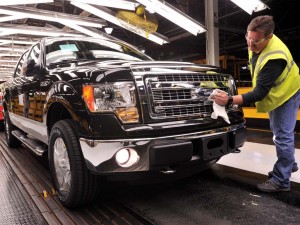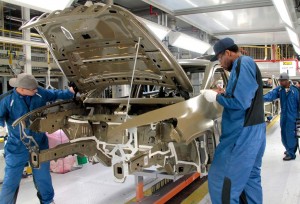Even with new plants coming on line in Mexico, the North American auto industry is rapidly running up against the limits of its capacity as manufacturers struggle to keep up with the demand for new vehicles.
But after losing billions in the run-up to the last recession, and then responding with massive factory cutbacks, automakers are reluctant to build capacity back up – only to find themselves in the same mess the next time the economy cools, analysts noted during the Center Automotive Research’s annual Management Briefing Seminar in Traverse City.
“This is a very new space for the industry,” said Jeff Schuster, senior vice president for forecasting for LMC Inc., who noted that with the memory of the Great Recession still fresh, manufacturers are wary of adding back new plants.
Nonetheless, carmakers like Ford are facing trouble if they don’t take steps to boost capacity. Limited available of key models like the Fusion, Escape and F-Series left Ford slipping into third place in July sales, behind Toyota. And LMC expects light vehicles sales to continue growing, with a forecast of 15.6 million units this year and 16.1 million units in 2014.
“Coming out of recession no one wanted to add capacity,” added Schuster. Now companies are scrambling to squeeze more units out of existing plants by adding shifts, speeding up line rates and putting employees on overtime schedules. “Once you get there, there is not a whole lot more you can do,” he said.
Honda and Nissan have new plants under construction in Mexico, which will be ready next year. However, Ford Motor Co. may have to decide soon whether to make a major investment in capacity, Schuster said. “They’re probably the closest to running out of space,” he said.

A new Ford F-150 rolls off the maker's assembly line in Kansas City, Missouri -- which is launching a third shift..
The maker does have some new capacity coming on line in the near-term, however. It announced plans to add a third shift at a key F-Series plant this week and it is getting ready to launch production of the Fusion at the Flat Rock, Michigan plant it took over after a joint venture with Mazda ended last year.
(Ford adds third shift in Kansas City. Still faces capacity issues. Click Here for the story.)
GM, meanwhile, has been trying to minimize potential shortages of its new Chevrolet Silverado and GMC Sierra models by continuing to produce the old trucks during model changeover. But with pickups now the hottest products on the market, that may not be enough.
Sean McAlinden, a senior analyst with the Center for Automotive Research, said the surge in pickup trucks may force GM to consider a new assembly plant, which seemed unlikely only four years ago when the auto giant was mired in bankruptcy. In fact, it now looks as if a GM truck plant in the Detroit suburb of Pontiac, which could have been mothballed, was bulldozed prematurely back in 2011.
Mustafa Mohatarem, GM’s chief economist, said GM’s truck plants are running beyond full capacity. “It’s amazing if you look at the change. At the beginning of the year people were asking do you have too many truck,” said Mohatarem. “ Now we’re being asked are you sure you are going to have enough?”
Mohatarem now believes industry sales this year are very likely to come in at the “high end” of the company’s earlier forecast of between 15 million and 15.5 million units.
Putting up a new plant is no easy – or quick – solution. So, for now, manufacturers are looking for other ways to add capacity. For example, GM announced plans to invest an additional $167 million in its Spring Hill, Tennessee plant. Original built for the now-abandoned Saturn division, it was idled as GM went into Chapter 11.
(GM doubling investment in once-abandoned Spring Hill plant. Click Here for the full story.)
Honda is investing approximately $215 million in its Ohio operations to add new powertrain technologies and a technical training center at its engine plant in Anna, Ohio, Honda has invested a total of $2.7 billion in its North American operations in the last three years.
“For the 21st century of manufacturing, we believe our success will be defined by the successful interaction between our associates and technology,” said Rick Schostek, senior vice president of Honda North America, Inc. “Even as we introduce more sophisticated technologies in our products and in our plants, we are working to ensure that our associates are equipped with the skills required for the manufacturing requirements of the future. We view this investment in Honda people as critical to our future success.”
(Click Here for more on Honda’s plans.)
Schostek also said Honda continues to work closely with suppliers to eliminate bottlenecks or shortages that could slow production at the company assembly or engine plants. “Coming out of the recession, a lot of suppliers were gun shy,” he noted.
Chrysler Group LLC has announced that it will invest another $52 million in its engine plants in Trenton and Dundee, Michigan, to increase capacity of the Tigershark engine, creating nearly 298 new positions at the Trenton plant. Dundee will continue to assemble the Tigershark alongside the 1.4-liter FIRE engine and the World Gas Engine. Trenton North will receive $11.5 million to add an assembly line for the four-cylinder Tigershark.
“With the growing demand for our products, we are constantly evaluating how to best meet powertrain production requirements,” said Brian Harlow, Vice President and Head of Powertrain Manufacturing. “In this case, we are fortunate that we had an existing facility that could accommodate the additional capacity needs for Tigershark and one that has the know-how to support that additional production.”
The expanded engine capacity should come on line during the third quarter, according to Chrysler. That could prove critical as it boosts its vehicle production. The biggest challenge there for the third-largest domestic maker has been with Jeep. The big Toledo plant has been down all year as it converts from the old Liberty model to handle the new Cherokee. As a result, Jeep sales have been in a slump even as overall Chrysler sales have now shown gains for 40 consecutive months.
CEO Sergio Marchionne recently said he will never again authorize a complete plant shutdown for a model changeover.

